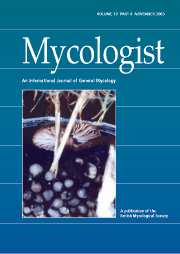Crossref Citations
This article has been cited by the following publications. This list is generated based on data provided by
Crossref.
Bridge, Paul D.
Roberts, Peter J.
Spooner, Brian M.
and
Panchal, Gita
2003.
On the unreliability of published DNA sequences.
New Phytologist,
Vol. 160,
Issue. 1,
p.
43.
Selosse, Marc-André
and
Durrieu, Guy
2004.
Une classification mycologique phylogénétique francophone (en 2003).
Acta Botanica Gallica,
Vol. 151,
Issue. 1,
p.
73.
Nouhra, Eduardo R.
Domínguez, Laura S.
Becerra, Alejandra G.
and
Trappe, James M.
2005.
Morphological, molecular and ecological aspects of the South American hypogeous fungusAlpova austroalnicolasp. nov..
Mycologia,
Vol. 97,
Issue. 3,
p.
598.
Råberg, Ulrika
Högberg, Nils O.S.
and
Land, Carl Johan
2005.
Detection and species discrimination using rDNA T-RFLP for identification of wood decay fungi.
Holzforschung,
Vol. 59,
Issue. 6,
p.
696.
Hooley, Paul
and
Whitehead, Michael
2006.
The genetics and molecular biology of marine fungi.
Mycologist,
Vol. 20,
Issue. 4,
p.
144.
Bärlocher, Felix
2007.
Molecular approaches applied to aquatic hyphomycetes.
Fungal Biology Reviews,
Vol. 21,
Issue. 1,
p.
19.
Xu, Zhihan
Harrington, Thomas C.
Gleason, Mark L.
and
Batzer, Jean C.
2010.
Phylogenetic placement of plant pathogenic Sclerotium species among teleomorph genera.
Mycologia,
Vol. 102,
Issue. 2,
p.
337.
Nieguitsila, A.
Goldenberg, O.
Deville, M.
Arné, P.
Benoît-Valiergue, H.
Chermette, R.
Latouche-Cottenot, S.
Pissard, S.
and
Guillot, J.
2010.
Molecular monitoring of fungal communities in air samples by denaturing high-performance liquid chromatography (D-HPLC).
Journal of Applied Microbiology,
Vol. 109,
Issue. 3,
p.
910.
Bärlocher, Felix
2010.
Molecular approaches promise a deeper and broader understanding of the evolutionary ecology of aquatic hyphomycetes.
Journal of the North American Benthological Society,
Vol. 29,
Issue. 3,
p.
1027.
Aveskamp, M.M.
de Gruyter, J.
Woudenberg, J.H.C.
Verkley, G.J.M.
and
Crous, P.W.
2010.
Highlights of the Didymellaceae: A polyphasic approach to characterise Phoma and related pleosporalean genera.
Studies in Mycology,
Vol. 65,
Issue. ,
p.
1.
Paz, Z.
Komon-Zelazowska, M.
Druzhinina, I. S.
Aveskamp, M. M.
Shnaiderman, A.
Aluma, Y.
Carmeli, S.
Ilan, M.
and
Yarden, O.
2010.
Diversity and potential antifungal properties of fungi associated with a Mediterranean sponge.
Fungal Diversity,
Vol. 42,
Issue. 1,
p.
17.
Chen, Yuanyuan
Prior, Bernard A.
Shi, Guiyang
and
Wang, Zhengxiang
2011.
A rapid PCR-based approach for molecular identification of filamentous fungi.
The Journal of Microbiology,
Vol. 49,
Issue. 4,
p.
675.
Smith, David
2012.
Advances in Applied Microbiology Volume 79.
Vol. 79,
Issue. ,
p.
73.
Lin, Zhenyue
Wei, Jingjing
Zhang, Muqing
Xu, Shiqiang
Guo, Qiang
Wang, Xin
Wang, Jihua
Chen, Baoshan
Que, Youxiong
Deng, Zuhu
Chen, Rukai
and
Powell, Charles A.
2015.
Identification and Characterization of a New Fungal Pathogen Causing Twisted Leaf Disease of Sugarcane in China.
Plant Disease,
Vol. 99,
Issue. 3,
p.
325.
Li, De-Wei
2016.
Biology of Microfungi.
p.
1.
Nanagulyan, Siranush
and
Margaryan, Lusine
2023.
Biodiversity of Armenia.
p.
143.

